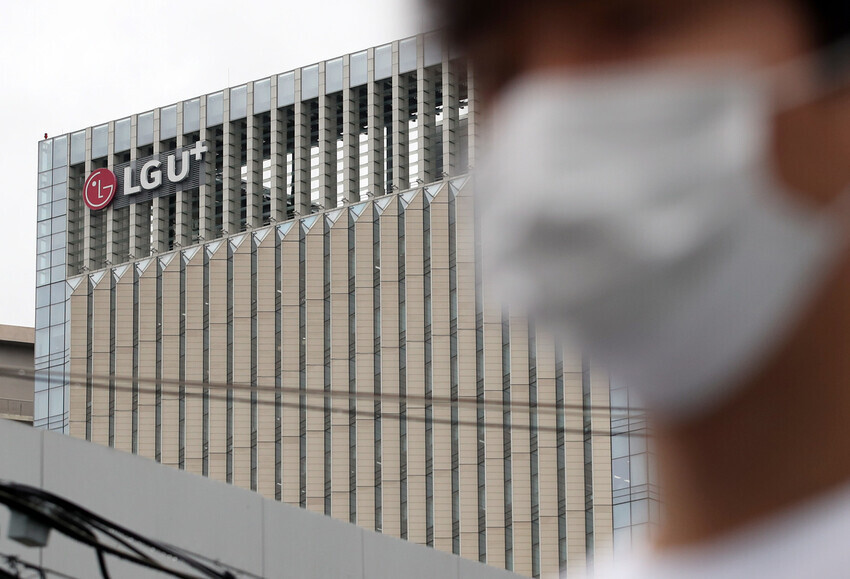hankyoreh
Links to other country sites 다른 나라 사이트 링크
US cranks up pressure on S. Korean telecoms to abandon Huawei and Chinese technology

The US government continues to crank up pressure on telecoms to avoid using equipment made by Chinese company Huawei, labeling companies that ditch Huawei products as “clean telcos” and pushing other companies to join the anti-Huawei front. That raises the question of how the US government’s overt campaign is impacting South Korean firms.
“We would urge companies like LG [Uplus] to migrate away from untrusted vendors [of telecommunications equipment] to trusted vendors,” Robert Strayer, the US’ deputy assistant secretary of state for cyber and international communications and information policy, said during a videoconference hosted by the New York Foreign Press Center on July 21.
“We think in the future there’s going to be growing demand [. . .] from critical infrastructure owners and operators to be using trusted vendors,” Strayer said, referring to companies whose “autonomous vehicles or smart manufacturing or telemedicine are built on top of 5G.”
That’s a call for action from LG Uplus, the only South Korean telecom that relies on Huawei for its base station equipment. SKT and KT had also seriously considered acquiring Huawei equipment in the initial phase of their 5G operations, but opted not to after the US raised security concerns.
Purely from a cost-benefit analysis, the general view in the industry is that Huawei gives telecoms more bang for their buck, offering outstanding equipment for prices that allow savings of more than 30%.
LG Uplus said that US pressure had put it in an awkward position but that it didn’t plan to release a statement. “Security issues are just an excuse for the US, and telecoms in weaker countries are collateral damage in its hegemonic struggle with China,” an industry source told the Hankyoreh over the phone.
The situation gets more complicated when the discussion turns to wired networks. Huawei’s internal networking equipment is reportedly in use at a considerable number of South Korea’s large corporations, online portals, and financial firms. “Practically speaking, it’s hard to set up or operate a wired network without using equipment from Huawei,” a company CEO said.
But industry insiders generally think that Washington’s arm-twisting won’t get the results it wants. For LG Uplus to divest of Huawei equipment, it would have to rebuild its LTE communications grid from the ground up, which would be prohibitively expensive. During the briefing on Tuesday, Strayer admitted that the US was “probably not going to provide any financial incentives” for LG Uplus to do so. And given the South Korean government’s relationship with China, chances are virtually nil that Seoul would explicitly ban the use of Huawei equipment.
A South Korean official kept their distance from that prospect, observing that “as for network security and safety, it’s up to each telecom to decide which company’s equipment to use.”
In a previous trade spat with China, the South Korean government considered restricting imports of Chinese garlic, only to back down when China countered by moving to restrict imports of South Korean mobile phones.
By Kim Jae-seob, senior staff writer
Please direct comments or questions to [english@hani.co.kr]

Editorial・opinion
![[Column] The state is back — but is it in business? [Column] The state is back — but is it in business?](https://flexible.img.hani.co.kr/flexible/normal/500/300/imgdb/original/2024/0506/8217149564092725.jpg) [Column] The state is back — but is it in business?
[Column] The state is back — but is it in business?![[Column] Life on our Trisolaris [Column] Life on our Trisolaris](https://flexible.img.hani.co.kr/flexible/normal/500/300/imgdb/original/2024/0505/4817148682278544.jpg) [Column] Life on our Trisolaris
[Column] Life on our Trisolaris- [Editorial] Penalties for airing allegations against Korea’s first lady endanger free press
- [Editorial] Yoon must halt procurement of SM-3 interceptor missiles
- [Guest essay] Maybe Korea’s rapid population decline is an opportunity, not a crisis
- [Column] Can Yoon steer diplomacy with Russia, China back on track?
- [Column] Season 2 of special prosecutor probe may be coming to Korea soon
- [Column] Park Geun-hye déjà vu in Yoon Suk-yeol
- [Editorial] New weight of N. Korea’s nuclear threats makes dialogue all the more urgent
- [Guest essay] The real reason Korea’s new right wants to dub Rhee a founding father
Most viewed articles
- 1[Column] Why Korea’s hard right is fated to lose
- 2Amid US-China clash, Korea must remember its failures in the 19th century, advises scholar
- 3[Column] The state is back — but is it in business?
- 460% of young Koreans see no need to have kids after marriage
- 5AI is catching up with humans at a ‘shocking’ rate
- 6Hybe-Ador dispute shines light on pervasive issues behind K-pop’s tidy facade
- 7Japan says it’s not pressuring Naver to sell Line, but Korean insiders say otherwise
- 8S. Korean chaebols comprise 84% of GDP but only 10% of jobs
- 9[Column] Can Yoon steer diplomacy with Russia, China back on track?
- 10Gangnam murderer says he killed “because women have always ignored me”